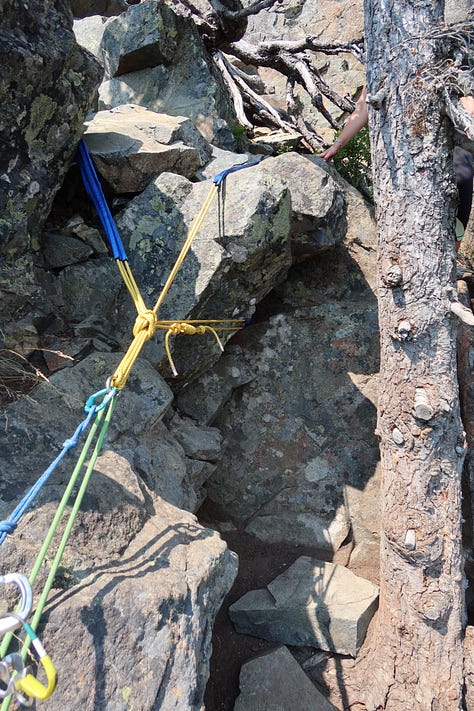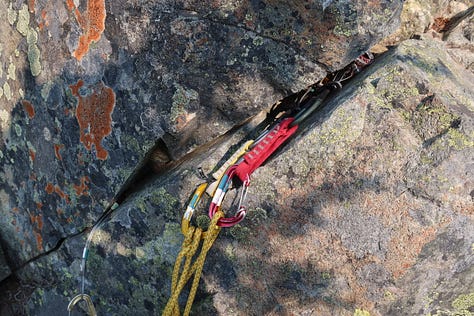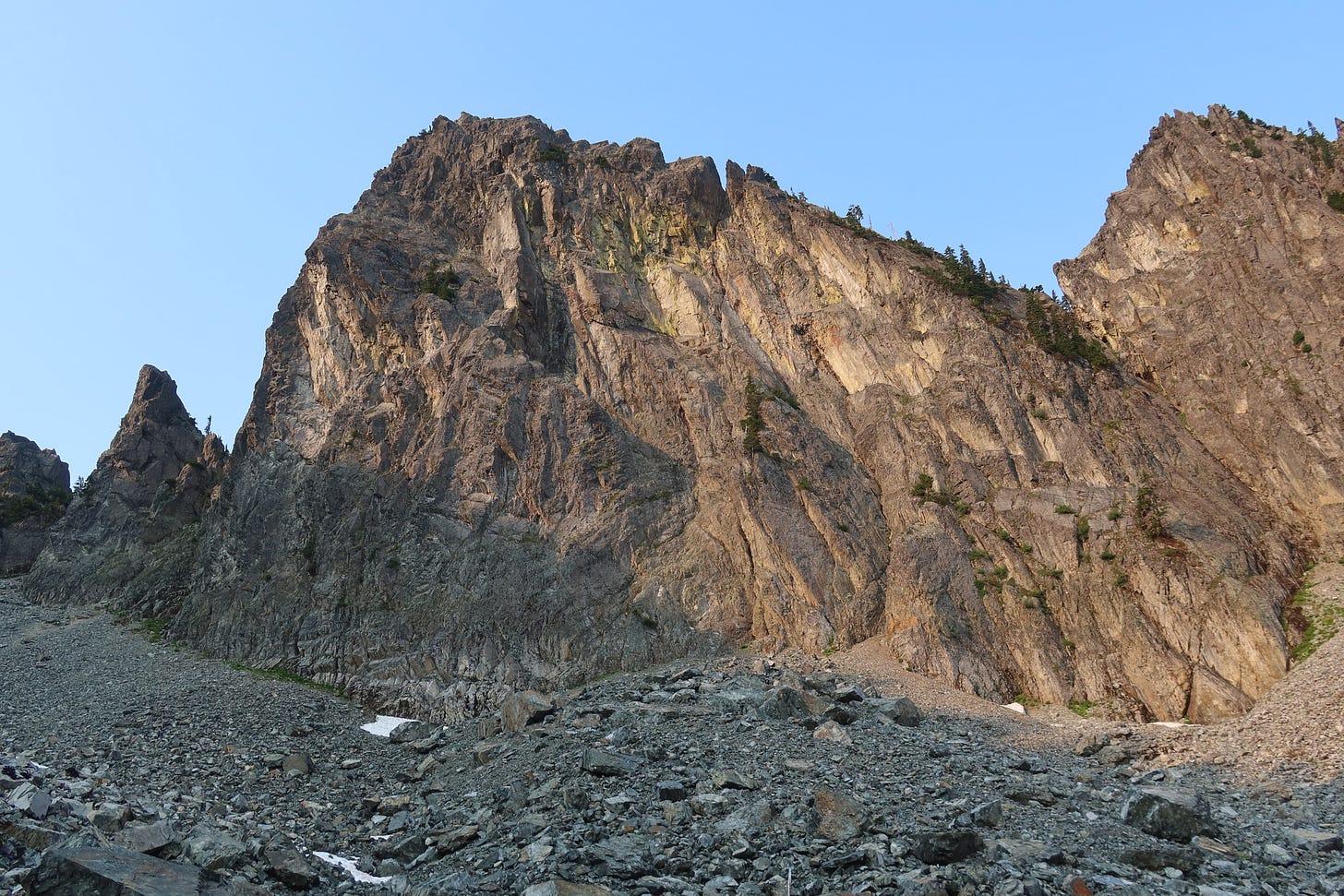Das Toof
Dawn was barely illuminating the peaks around us as we passed the trailhead map to begin our approach. It was 5:38 in the morning and I’d been up since 3:15. I’d blasted music to keep myself awake in the car, my nerves tingling as I drove out of the city and into the mountains.
We hadn’t been hiking more than a minute before the sound of laughter and the thump of bass started creeping up behind us. A group of about 6 college-aged boys passed us like a herd of elephants and the one at the back had a giant boombox speaker slung over his shoulder.
“Do you think they even slept last night?” I smirked, but their enthusiasm was contagious. “I wonder how much that speaker even weighs,” my climbing partner mused with a smile on his face. We didn’t see the group again, but I swore I could hear the phantom echo of that bass in the valley hours later.
What was I doing up so early myself? Along with three other Mountaineers members, I was attempting a summit of The Tooth, Snoqualmie Pass’s most classic alpine climb. We started early because this day would be long, demanding, and hot.
What is an alpine rock climb? An alpine climb involves trying to summit a peak. That is usually far away from the trailhead. And involves technical rock climbing. And maybe ice, snow, or even glaciers. It takes years to develop proficiency in all of the skills required to be an alpine climber; luckily for me, I was joining this trip as a student after completing a course in following alpine rock this past spring.
The Tooth is a peak in the Snoqualmie Pass area of the Central Cascades. It was first climbed in 1916 by Charles Hazelhurst and C.G. Morrison (I would have loved to see the gear they carried). Since then, it’s been climbed by countless beginning alpinists and is popular for its relatively easy routes.
A few definitions:
Approach: the hike/scramble to the base of the rock wall, after which you gear up to climb.
Pitch: a section of a climb that is roughly one rope’s length. You climb one pitch at a time.
Traditional (trad) protection: gear that is placed in natural rock features like cracks and is removed as the next person climbs. An alternative to this is a route with permanent bolts that you clip into as you ascend. Many alpine climbs are trad due to their remote and rugged nature.
Leader/follower: the leader is the climber who ascends the pitch first, placing the trad gear as they go. The follower belays them from below. Once the leader gets to the top of the pitch, they belay the follower from above. The follower removes the trad gear as they climb, eventually reaching the leader. Rinse & repeat.



The quick stats
How far was the hike? The approach was roughly 3.5 miles and 2300 feet of vertical gain. The established trail gave way to a moderately steep boulder field around 2 miles in and there was no snow in mid-August.
How heavy was your pack? What was in it? My pack was roughly 30 pounds when I started. I carried my Ten Essentials, climbing gear, food, water, and a rope.
How hard was the climbing? The climb is rated at a 5.4 on the Yosemite Decimal Scale, which means that it’s on the easier end of difficulty. There were lots of big handholds and ledges to use on the way up, and several members of our climbing party wore approach shoes or boots as opposed to climbing shoes.
How long did it take? Car-to-car was 11 hours. The approach took 2h45m, climb took 2h, rappelling took 2h30m, and the hike back out (de-proach?) took 2h30m. There was some time in there for gearing up and hanging at the summit.
How much water did you drink? I packed 4 liters with me and finished it with 2 miles to go. Luckily we had a water filter so I got to indulge in some ice cold mountain spring water.
How many calories did you burn? My Garmin estimated 6500 calories burned.


Learnings & reflections
I need to train more. With a much heavier pack.
Partway up the scramble through the talus field, I started to feel pin pricks in my vision and my heart rate was climbing. Every step was an effort for my legs. I had climbed stairs and hiked in the last month, but not with 30 pounds on my back.
“How about if I carry the rope for a little while?” my climb leader asked and I nearly hurled the rope at him in relief.
“I’ve had the good fortune of training with much heavier packs this summer already.” I was so thankful for his graciousness and reassurance. I felt a touch lighter on my feet, but this feeling started to fade as I looked up at our destination which was still 500 feet higher.
The approach, which is regarded as easy by most guidebooks, was a personal challenge due to my current level of fitness. In fact, I was more nervous for this than the actual climbing! Although I knew going into the day that the approach would be difficult, the experience further underlined that I need to increase my training. In the alpine, being efficient and speedy means being safe. I will add more weighted conditioning into my routine going forward.
Getting up early pays off.
For all of the reasons mentioned earlier, The Tooth is a popular climb. Our trip leader anticipated this and instructed us to get to the trailhead by 5:30AM. It was painful waking up at 3:15 and making the dark drive, but it meant that we arrived at the base of the climb with no other parties in front of us. There was one pair of climbers a couple of pitches up who told us they had camped out the night before, and two other groups arrived minutes after us.
An alpine climb is like a one-way street with two-way traffic, as there is a limited amount of space at the belay stations. Arriving early means far fewer delays. In all, I estimate that we encountered about 20 other climbers on the route that day.
My climbing systems feel more dialed in.
This was my second-ever multi-pitch climb and a culmination of two years of learning. I used skills in belaying, climbing, knots, rope management, rappelling, route finding, scrambling, and gear management. Although I don’t yet have the knowledge of how to lead trad climbs, I have spent hours learning and practicing my skills to be an efficient and responsible climber.
My practice paid off on The Tooth when I felt surprisingly comfortable with multi-pitch transitions and rappelling, two skills that are new for me. I’m incredibly proud of myself for my dedication to this sport and hobby, and it was encouraging to feel confident in my skills on an actual climbing trip.
I can do hard things.
It’s a touch cheesy, but the simplicity of this statement hits home when the hill gets steep. I often repeat this to myself on tough training hikes, and sure as hell I was repeating it on The Tooth. It serves as a reminder that no matter the physical or emotional challenge, I have done hard things before and will do them once more.
Always keep water and clothes in the car.
On a more practical note, I was grateful to have a 2-liter water bottle waiting in my car, in addition to fresh clothes and socks. As I was peeling my hiking socks off my sweaty and sore feet, a woman walked over with her dog and asked if I had extra water. She had run out and was worried about her pup after the 80-degree hike. I jumped up with only one shoe on to pour her some from my car stash. It underscored why I always keep extra water, food, and first aid materials in my car at the trailhead; I may not be the only one needing the resources.
What’s next
With a successful rock summit under my belt, I am nearly qualified to “graduate” my alpine rock course (yay!). I feel inspired to use the rest of my summer and fall to climb more indoors and at local crags as well as get outside every weekend for hiking. I have back-to-back weekend camping trips coming up, so August is shaping up to be a very outdoors-focused month. Oh, and I’ll add a few bricks to my pack for some extra conditioning ;)
See u on trail :)









Nice climb!